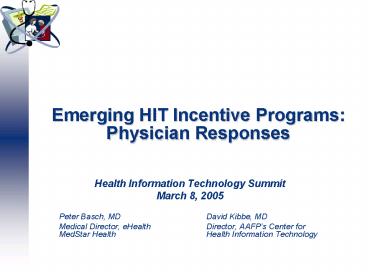Emerging HIT Incentive Programs: Physician Responses - PowerPoint PPT Presentation
Title:
Emerging HIT Incentive Programs: Physician Responses
Description:
Medical Director, eHealth Director, AAFP's Center for MedStar Health Health ... AAFP, ACP, other medical specialty societies; KLAS, HIMSS, others ... – PowerPoint PPT presentation
Number of Views:42
Avg rating:3.0/5.0
Title: Emerging HIT Incentive Programs: Physician Responses
1
Emerging HIT Incentive Programs Physician
Responses
- Health Information Technology Summit
- March 8, 2005
- Peter Basch, MD David Kibbe, MD
- Medical Director, eHealth Director, AAFPs
Center for MedStar Health Health Information
Technology
2
Bios
- Peter Basch, MD
- General internist
- Medical Director, eHealth MedStar Health
- Co-Chair PEHRC
- Co-Chair of the Small Practice Workgroup of eHI
- David C. Kibbe, MD, MBA
- Family physician
- Director, Center for Health Information
Technology - Co-Chair PEHRC
- Co-Chair of the Small Practice Workgroup of eHI
3
Overview
- Barriers to HIT adoption
- Why are incentives necessary?
- Responses to key HIT incentive programs
4
Risks / barriers to HIT adoption?
- Physicians are not computer phobic
- Physician culture is pro-quality / safety
- Computers are affordable / reliable
- Connectivity is affordable / reliable
- Software is reliable, and often affordable
- Why havent physicians accelerated adoption of
HIT? - Risks / barriers to adoption
- Risks / barriers to interconnectivity
- Questionable (negative to very negative)
business case
5
Lowering Risks / Barriers to EHR Adoption
6
Lowering Risks / Barriers to EHR Adoption
7
Lowering Barriers to Interconnectivity
8
Lowering Barriers to Interconnectivity
9
Lowering Barriers to Interconnectivity
10
Creating the Business Case
11
Creating the Business Case
12
Creating the Business Case
13
Creating the Business Case
14
No money available
- For physicians access to loans is not a
problem - But willingness to borrow money for an uncertain
ROI is. - Nevertheless may be important for some doctors
15
Case for IT adoption (per se)
- Successful IT adoption by itself has not been
shown conclusively to improve quality or safety
(except where quality has been specifically
incented) - Without further specifying process / outcomes
measures as a requirement of reimbursement it
is clear that HIT will be used to further the
existing business case ? volume and right
coding
16
The business case for quality and information
management
- Computers are affordable
- Networking is affordable
- Broadband is affordable
- EHR software is affordable
- Interconnecting to all necessary sources of
information is affordable
17
The business case for quality and information
management
- Computers are affordable
- Networking is affordable
- Broadband is affordable
- EHR software is becoming more affordable
- Interconnecting to all necessary sources of
information will hopefully become affordable
(perhaps free) and may (if we are lucky)
improve quality and safety, and not result in
information overload, cookbook medicine, and/or
care confusion - Quality care (information) (knowledge)
(context) - Quality care micro-tasking
- Quality care ? time, cost, complexity
- Activities of quality care the above, and
population and disease management, non-visit
based care, and care coordination
18
Basic EHR
19
(No Transcript)
20
(No Transcript)
21
(No Transcript)
22
(No Transcript)
23
(No Transcript)
24
(No Transcript)
25
(No Transcript)
26
Decision support for patient
27
Integrated registry proactive use by clinicians
and staff
28
Advanced EHR Registry eVisits
29
Advanced EHR Registry eVisits HIE
PCPs and Specialists
Long-term Care Home Health
- Patient info
- Visit list
- Prob list
- Med list
- Allergy list
- CCR
Labs
- Patient info
- Visit list
- Prob list
- Med list
- Allergy List
- Discharge Sum
- ED Reports
- CCR
Community Hospitals
PBMs
- Reports
- Images
- Med lists
- Formulary
Tertiary Care Hospitals
Imaging Centers
- Diagnosis
- Claims History
- Eligibility
- Referrals
- Authorizations
- Claim Submission
- Claim Status
- Claim Remittance
Payors
Public Health
- Bio-surveillance
- Safety, quality, efficiency indicators
- Personal Health Record
Outcomes Measures
Patients
30
The business case for quality and information
management
- Computers are affordable
- Networking is affordable
- Broadband is affordable
- EHR software is becoming more affordable
- Interconnecting to all necessary sources of
information will hopefully become affordable
(perhaps free) and may (if we are lucky)
improve quality and safety, and not result in
information overload, cookbook medicine, and/or
care confusion - Quality care (information) (knowledge)
(context) - Quality care micro-tasking
- Quality care ? time, cost, complexity
- Activities of quality care the above, and
population and disease management, non
face-to-face care, and care coordination
31
Existing P4P initiatives
bad, to
completely meets goals
32
Preferred P4P initiatives
bad, to
completely meets goals
33
Summary
- There are many risks and barriers to HIT adoption
that can and should be lowered - Interoperability only sets the stage meaningful
clinical interconnectivity will determine its
value - Payers must create a sustainable positive
business case for adoption and optimal use
(recognizing the implications to the practice) - HIT adoption per se may add little or no net cost
to a practice, and may produce little or no net
value for the patient may require a
jump-start, but will not require ongoing
incentives - Integration of HIT into some practice settings
can lead to ?
quality/safety/efficacy/access (? HIT value), and
doing so will ? provider
time/cost/complexity (? practice costs)
requires ongoing structural reimbursement changes - Incentives should not just be based on numerical
targets, as healthcare transformation enabled
thru HIT includes other key elements, such as
meaningful care coordination / management,
collaboration with patients, and optimal use of
non face-to-face care (none of which will occur
without fundamental reimbursement reform)































